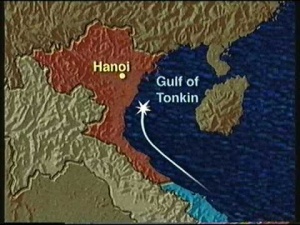"Gulf of Tonkin Incident"
 | |
| Date | 2 August 1964 - 4 August 1964 |
|---|---|
| Perpetrators | US Navy |
| Blamed on | North Vietnam |
| Deaths | 4 |
| Injured (non-fatal) | 6 |
| Exposed by | William Bader |
| Description | Two faked attacks used by the USA as a casus belli to commit ground forces to the Vietnam War. |
The "Gulf of Tonkin Incident" was cited as the casus belli for the USA to commit ground forces to the war in Vietnam. It refers to 2 claimed incidents involving the naval destroyer USS Maddox on 2 and 4 August 1964 respectively, both of which are alleged to have involved unprovoked aggression against the US ship by the Vietnamese . According to an NSA investigation which was declassified in 2010, only one of the claimed incidents actually took place. [1] The report also reveals that the seriousness of the incident which did take place is at best questionable, in terms of a genuine casus beli for full-scale war. For example, it was the USS Maddox which fired the first (warning) shots, there were no US casualties and there were 4 North Vietnamese sailors killed and 6 wounded, with no damage to the US ship and extensive damage to three Vienamese torpedo boats. [1]
Contents
US Provocation
On August 3, US Treasury Secretary, Robert Anderson secretly recorded a call he received from Lyndon B Johnson. This provides evidence of US provocation of the attacks:
“OK. Here’s what we did. We [were] within their 12-mile limit, and that’s a matter that hasn’t been settled. But there have been some covert operations in that area that we have been carrying on – blowing up some bridges and things of that kind, roads, and so forth. So I imagine they wanted to put a stop to it. So they come out there and fire and we respond immediately with five-inch guns from the destroyer and with planes overhead. And we cripple them up – knock one of them out and cripple the other two. And then we go right back where we were with that destroyer [the Maddox], and with another one [the Turner Joy], plus plenty of planes standing by. And that’s where we are now.”
Lyndon Johnson (1964-08-03) [2]
Declassified documents
The NSA declassified and released nearly 200 documents relating to this incident in 2005 and 2006.[3]
Related Quotation
| Page | Quote | Author | Date |
|---|---|---|---|
| Document:The Deep State and 9/11 | “Many of the people who were associated with the war were looking for any excuse to initiate bombing. The sending of a destroyer up the Tonkin Gulf was primarily for provocation. ... There was a feeling that if the destroyer got into some trouble, that it would provide the provocation we needed. [1]” | George Ball | 1977 |
Related Documents
| Title | Type | Publication date | Author(s) | Description |
|---|---|---|---|---|
| Document:MH-17 Mystery: A New Tonkin Gulf Case? | article | 17 July 2015 | Robert Parry | A First anniversary retrospective drawing a compelling parallel with the 'Gulf of Tonkin incident' which became the casus belli for the Vietnam war. |
| Document:Peter Dale Scott - COPA 2010 | speech | 2010 | Peter Dale Scott | |
| Document:The sinking of the Cheonan: Another Gulf of Tonkin incident | article | 20 May 2010 | Stephen Gowans | A parallel between the Cheonan incident and the Gulf of Tonkin. |
The Official Culprit
| Name | Description |
|---|---|
| Vietnam | The Socialist Republic of Vietnam is the 15th most populous country. Known most famously for the Vietnam War. |
References
- ↑ a b Robert J. Hanyok, "Skunks, Bogies, Silent Hounds, and the Flying Fish: The Gulf of Tonkin Mystery, 2-4 August 1964", Cryptologic Quarterly, Winter 2000/Spring 2001 Edition, Vol. 19, No. 4 / Vol. 20, No. 1.
- ↑ http://nuclearrisk.wordpress.com/2013/03/17/fool-me-once-avoiding-needless-wars-part-1-the-first-gulf-of-tonkin-incident/ Nuclear Risk
- ↑ http://www.usni.org/magazines/navalhistory/2008-02/truth-about-tonkin
References
<references>